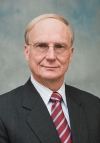KEYNOTE 1: The Dawn of 5G II: Vision, Technology, and Progress
Edward G. Tiedemann, Jr.(Senior Vice-President, Engineering Qualcomm Technologies, USA) |
 |
Abstract
At VTC 2013, the author gave a presentation called the Dawn of 5G. At that time, there was little discussion of 5G and many were even questioning whether 5G was needed. In the past three years, a tremendous amount of progress has been made. The ITU has completed a preparation phase with the release of several vision documents, and 3GPP has embarked upon a next generation standardization program. This presentation begins by summarizing the 5G vision with its three pillars of enhanced mobile broadband, massive machine type communications, and ultra-reliable and low latency communications with operation in licensed, unlicensed, and shared spectrum bands over an extremely wide range of frequencies. The vision for 5G also includes integrated relays, fronthaul, backhaul, and device-to-device communications. 5G will incorporate techniques such as Massive MIMO, self-contained sub-frames, and a device-centric MAC. The combination of these advanced techniques is focused on providing not only the flexibility to support growing use cases in a very diverse set of frequency bands but also the performance, capacity, and scalability required for cost effective 5G services.
CV
Dr. Edward G. Tiedemann, Jr. is a QUALCOMM Fellow and a Senior Vice President of Engineering of QUALCOMM Technologies, Inc. He leads QUALCOMM’s worldwide standardization and industry organization activities. Dr. Tiedemann was instrumental in the design and development of the TIA/EIA/IS-95 CDMA system, also called cdmaOne™. He led QUALCOMM’s and much of the industry’s efforts in the design and development of the third-generation cdma2000® system. He currently sits on the board of several industry organizations, and is active in setting the direction for 5th generation wireless systems. Dr. Tiedemann was General Chair of GLOBECOM 2015, one of the IEEE Communications Society flagship conferences. Dr. Tiedemann holds the Ph.D. degree from MIT where he worked in the areas of queueing theory and communications networks. He holds the Master of Science degree from Purdue University where he worked on bandwidth efficient modulation. He also holds the Bachelor of Science degree from Virginia Polytechnic Institute and State University (Va Tech).



